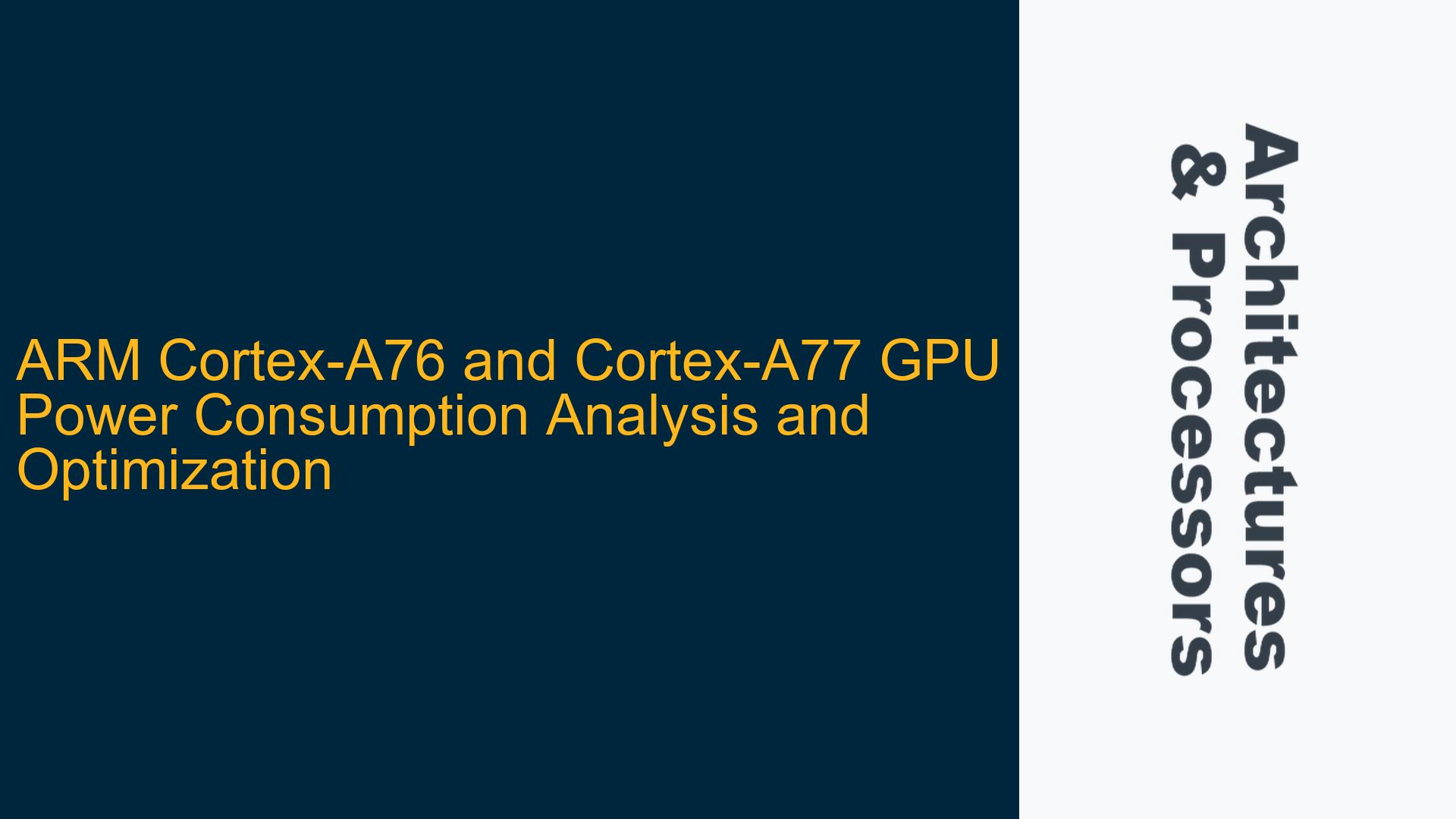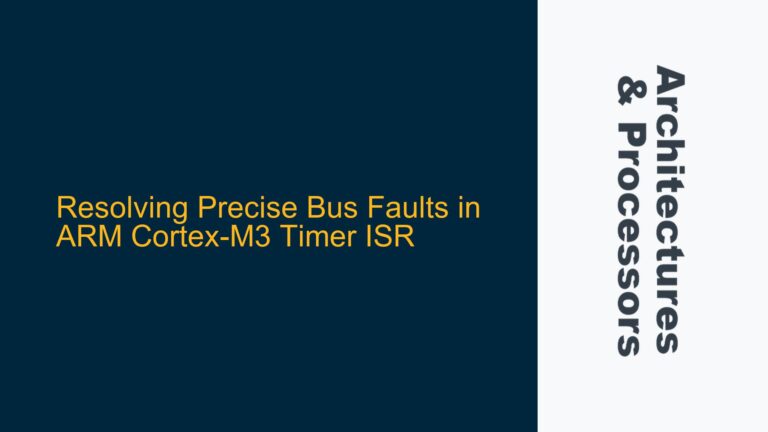ARM Cortex-A76 and Cortex-A77 GPU Power Consumption in Normal State
The power consumption of the ARM Cortex-A76 and Cortex-A77 GPUs in their normal operational state is a critical factor for system designers, especially in mobile and embedded applications where power efficiency is paramount. The Cortex-A76 and Cortex-A77 are high-performance cores designed for advanced applications, and their GPUs are integral to their overall power profiles. Understanding the power consumption of these GPUs requires a deep dive into their architectural differences, operational characteristics, and the factors that influence their power draw.
The Cortex-A76 GPU, part of the ARM Mali family, is designed for balanced performance and power efficiency. It typically operates at a lower power envelope compared to the Cortex-A77 GPU, which is optimized for higher performance and thus consumes more power. The Cortex-A77 GPU, also part of the Mali family, incorporates more advanced features such as enhanced shader cores, improved memory bandwidth utilization, and higher clock speeds, all of which contribute to increased power consumption.
In a normal state, the power consumption of these GPUs is influenced by several factors including the workload type, clock frequency, voltage levels, and thermal conditions. For instance, a GPU under heavy graphical load will consume more power than one in an idle or low-utilization state. Additionally, the manufacturing process node (e.g., 7nm, 5nm) plays a significant role in determining the power efficiency of these GPUs. Newer process nodes generally offer better power efficiency due to reduced leakage currents and lower dynamic power consumption.
To provide a more concrete understanding, let’s consider typical power consumption figures. The Cortex-A76 GPU, when operating at its base frequency, might consume around 1.5W to 2W under moderate graphical workloads. In contrast, the Cortex-A77 GPU, due to its higher performance capabilities, could consume between 2.5W to 3.5W under similar conditions. These figures are approximate and can vary based on the specific implementation, cooling solutions, and power management strategies employed by the system integrator.
Architectural Differences and Their Impact on Power Consumption
The architectural differences between the Cortex-A76 and Cortex-A77 GPUs are significant and directly impact their power consumption profiles. The Cortex-A76 GPU is built on a more conservative design philosophy, focusing on a balance between performance and power efficiency. It features fewer shader cores, a simpler memory subsystem, and lower clock speeds compared to the Cortex-A77 GPU. These design choices result in lower power consumption but also limit the peak performance capabilities of the Cortex-A76 GPU.
On the other hand, the Cortex-A77 GPU is designed to push the boundaries of performance, making it more suitable for demanding applications such as high-end gaming, augmented reality, and machine learning tasks. It incorporates a larger number of shader cores, a more complex memory hierarchy, and higher clock speeds. These enhancements allow the Cortex-A77 GPU to deliver significantly higher performance, but at the cost of increased power consumption.
One of the key architectural features that contribute to the higher power consumption of the Cortex-A77 GPU is its advanced memory subsystem. The Cortex-A77 GPU supports higher memory bandwidth and more efficient data prefetching mechanisms, which are essential for handling complex graphical workloads. However, these features also increase the power draw, especially during memory-intensive operations. Additionally, the Cortex-A77 GPU employs more aggressive clock gating and power management techniques to mitigate power consumption, but these techniques are often insufficient to fully offset the increased power demands of its higher performance capabilities.
Another important factor is the thermal design power (TDP) of these GPUs. The Cortex-A76 GPU typically has a lower TDP compared to the Cortex-A77 GPU, which means it can operate within a lower power envelope without requiring extensive cooling solutions. In contrast, the Cortex-A77 GPU, with its higher TDP, often necessitates more sophisticated cooling mechanisms to maintain optimal operating temperatures, further adding to the overall power consumption of the system.
Optimizing Power Consumption in ARM Cortex-A76 and Cortex-A77 GPUs
Optimizing the power consumption of ARM Cortex-A76 and Cortex-A77 GPUs involves a combination of hardware and software strategies. At the hardware level, selecting the appropriate manufacturing process node is crucial. Newer process nodes, such as 5nm or 4nm, offer significant improvements in power efficiency due to reduced leakage currents and lower dynamic power consumption. System designers should also consider the integration of advanced power management units (PMUs) that can dynamically adjust voltage and frequency levels based on the workload requirements.
At the software level, optimizing the GPU drivers and firmware is essential for minimizing power consumption. This includes implementing efficient workload scheduling algorithms that can distribute tasks across the GPU cores in a way that minimizes power draw. Additionally, leveraging ARM’s Dynamic Voltage and Frequency Scaling (DVFS) techniques can help in dynamically adjusting the GPU’s operating frequency and voltage based on the current workload, thereby reducing power consumption during periods of low activity.
Another important software optimization technique is the use of power-aware rendering algorithms. These algorithms are designed to reduce the computational complexity of graphical tasks without significantly impacting the visual quality. For example, techniques such as level-of-detail (LOD) rendering, texture compression, and efficient shader code optimization can help in reducing the GPU’s workload, thereby lowering its power consumption.
Thermal management is also a critical aspect of power optimization. Implementing effective thermal throttling mechanisms can prevent the GPU from overheating, which not only ensures stable operation but also helps in maintaining optimal power efficiency. This can be achieved through the use of temperature sensors and feedback loops that adjust the GPU’s performance based on the current thermal conditions.
In conclusion, the power consumption of ARM Cortex-A76 and Cortex-A77 GPUs in their normal state is influenced by a variety of factors including architectural design, manufacturing process, workload type, and thermal conditions. By understanding these factors and implementing appropriate optimization strategies, system designers can achieve a balance between performance and power efficiency, ensuring that these GPUs meet the demands of modern applications while maintaining acceptable power consumption levels.





